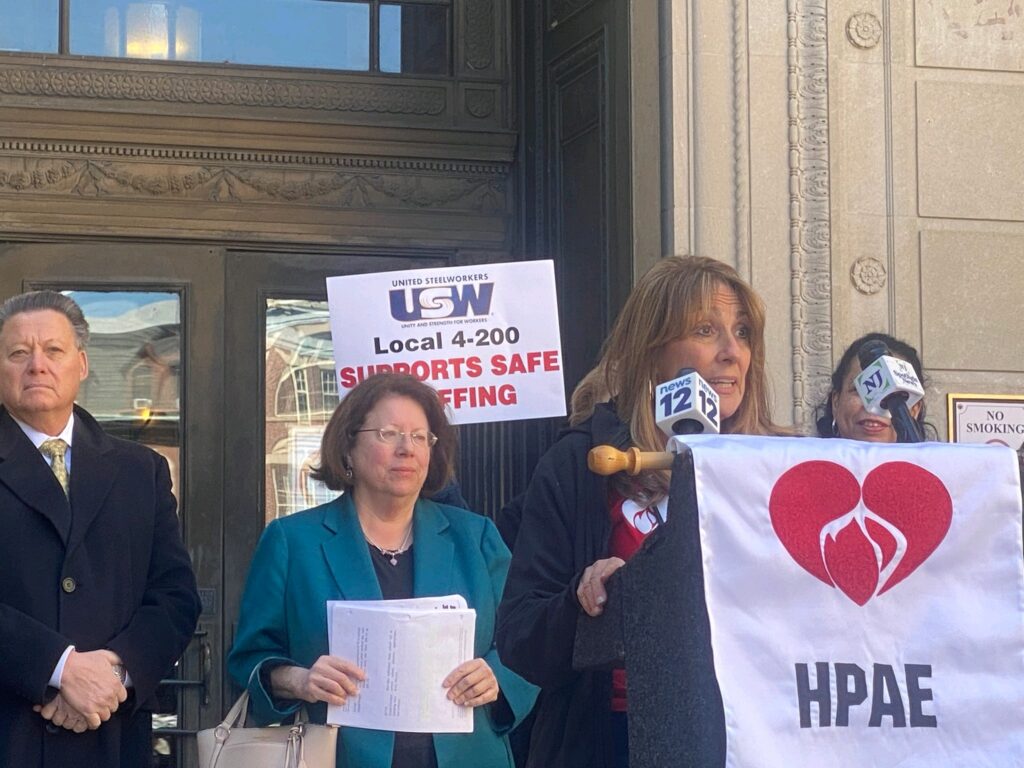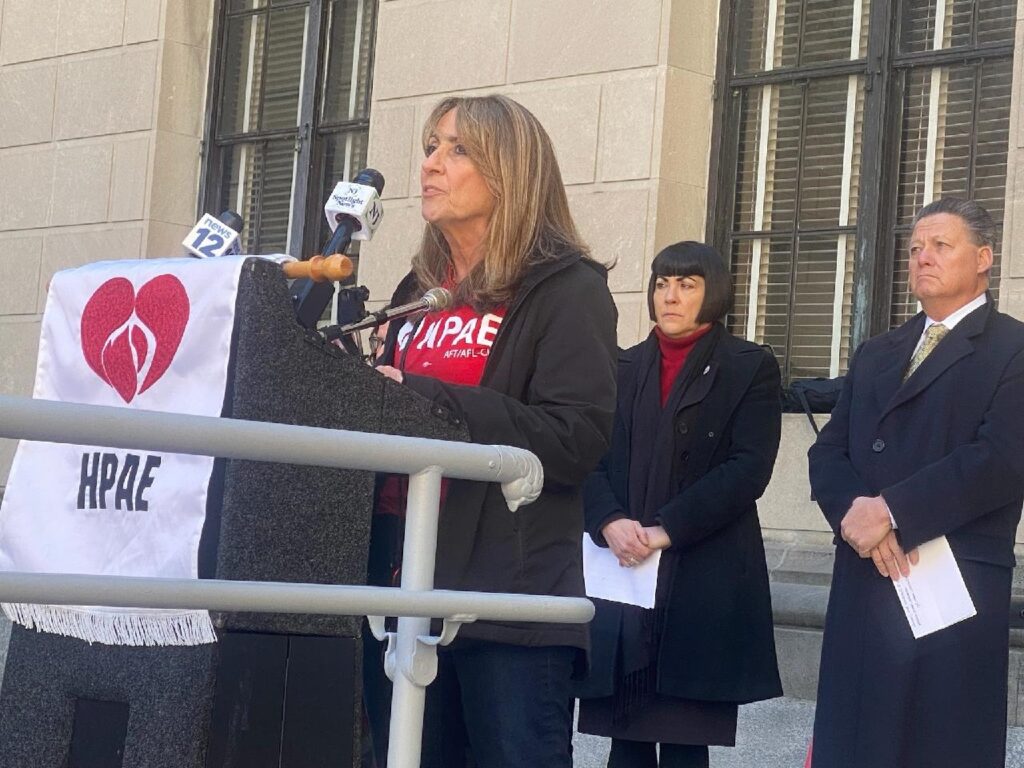Now or Never: NJ Nurses and NJ AFL-CIO Issue Code Red

Three years after New Jersey was upended by the COVID virus, a coalition of New Jersey’s healthcare unions are warning that without a legally enforceable nurse to patient ratio, nurses will continue to leave the state’s acute care hospitals already facing a skilled nursing shortage.
Legally mandated patient nurse ratios were first put on the books for acute care hospitals in 2004 in California and have since been adopted in at least some form in at least 14 states and the District of Columbia. The push in New Jersey has been ongoing for several years but has run into stiff resistance from the deep pocketed corporate hospital complex.
Advocates point to the well documented link between insufficient staffing levels and poor infection control as well as the investigation by the Guardian newspaper and Kaiser Health News Lost on the frontline which documented the deaths of 3,607 U.S. healthcare workers, including 268 in New Jersey in the first year of the COVID pandemic when N-95 masks were rationed.
“As the ratio goes up between patients and nurses goes up infections go up, lower nurse to patient ratio drops infections. That has been proven with much research over the last decade,” said Debbie White, RN and president of Health Professionals and Allied Employees, New Jersey’s largest nurses’ union. The crunch on nurse staffing comes as multiple studies have flagged a troubling spike in workplace attacks of varying severity on healthcare workers.
The Joint Commission, a non-profit, and the nation’s oldest accrediting body for hospitals, reported that workers in healthcare are at least four times more likely to be targeted for violence than other workers. “Alarmingly, the actual number of violent incidents involving health care workers is likely much higher because reporting is voluntary,” the Joint Commission concluded.
“The statistics are staggering,” according to surveys by the American College of Emergency Physicians (ACEP) and the Emergency Nurses Association (ENA), with “almost half of emergency physicians report being physically assaulted at work, while about 70 percent of emergency nurses report being hit and kicked while on the job.”
A UNITED FRONT
At a March 20 New Jersey State House press conference, nurses from Health Professionals and Allied Employees, JNESO District Council 1, SEIU 1199J, USW Local 4-200 were joined by Charlie Wowkanech, president of NJ AFL-CIO as well as by State Sen. Sen. Linda Greenstein (D-LD 14) and Assemblywoman Angelica Jimenez (LD-32) sponsors of the staffing bill NJ-S304/A-4536.
The union effort will culminate in a May 11th rally in Trenton.
“Our healthcare system is in crisis as we continue to lose dedicated healthcare professionals to burnout and stress,” Debbie White, RN and president of Health Professionals and Allied Employees, New Jersey’s largest nurses’ union, told a noon time State House rally. “For years we have been talking about safe staffing because why? We have witnessed the deliberate understaffing of our healthcare institutions by hospitals and healthcare corporations that cut staffing down to its lowest number to maximize profits.”
White told reporters that the staffing crisis predated COVID “because the work environment had become untenable.”
White’s warning is echoed in a medical research study funded by the Johnson & Johnson Foundation published last year in Health Affairs covering the entirety of 2021, that showed “the total supply of RNs decreased by more than 100,000 in one year—a far greater drop than ever observed over the past four decades.”
The authors cited “early retirements, pandemic burnout and frustration, interrupted work patterns from family needs such as childcare and elder care, COVID-19 infection and related staffing shortages, and other disruptions throughout health care delivery organizations.”
White cited a survey of New Jersey’s nursing workforce conducted by Change Research, an independent research consultant of over 500 nurses last August. What the pollsters found was that close to a third had left hospital bedside assignments over the past three years. The number one reason given for their exit was poor staffing with the second most frequently expressed rationale burnout and stress, which is directly linked to staffing.
EXIT STAMPEDE
Even more alarming was the finding that 72 percent of the nurses still working bedside had seriously considered leaving.
"We're calling on the legislature to listen to the essential workers and their constituents calling for them to take action on NJ-S304, which establishes minimum staffing standards for hospitals and other healthcare facilities," Wowkanech told reporters. "Our nurses are the backbone of our healthcare system. But current staffing levels are threatening our healthcare system's ability to provide the level of care we need, and it is taking its toll on already strained healthcare workers.”
“Our healthcare workers have been on the front lines of an unprecedented global pandemic,” Sen. Greenstein said. “Measures like this safe staffing bill are needed to improve working conditions at our hospitals, to ensure that staff is well-equipped to provide exceptional patient care, and ultimately, to save lives.”
"It is crucial that healthcare institutions maintain safe staffing levels to ensure patient safety and satisfaction, reduce healthcare costs, and improve nurse working conditions,” said Assemblywoman Jimenez. “By doing this, patients can recover from their ailments with comfort, satisfaction, and ease, and nurses can approach their work with the ease they desire.”
Elfrieda Johnson, President, JNESO District Council 1 IUOE-AFL-CIO, said Passing this bill would increase patient safety, patient satisfaction, and less burnout which would ultimately increase nurses job satisfaction.
“We need this bill because, safe staffing saves lives and increases job satisfaction,” said Elfrieda Johnson, president, JNESO District Council 1 IUOE-AFL-CIO. “When we don't have adequate nurse-to-patient ratios it can cause patient care to be compromised leading to job burnout and, in some cases, resulting in nurses leaving their career earlier than planned.”
Barbara Jones with JNESO District Council 1 IUOE-AFL-CIO, observed that there’s already been recognition in New Jersey of the value of setting patient nurse ratio standards.
“There are already staffing ratios in areas like the ICU and Labor and Delivery, so there is no reason why ratios shouldn’t be mandated to help the nurses in other units like Med-Surg and the ER that are overwhelmed and struggling to give the best care because they don’t have ratios in place,” Jones said.

UNIVERSAL ISSUE
"Making sure hospitals and other medical facilities have a safe number of staff to care for our loved ones affects every New Jerseyan – rich or poor, old and young, on all sides of the political divide," said Michele Liebtag of CWA. "This is an issue of savings lives and improving medical outcomes for everyone. As the Union representing regulators at the NJ Department of Health who inspect medical facilities and investigate complaints of short staffing, our members see the critical need to improve staffing.”
“We do not agree that a rigid government-mandated staffing ratio across all units is in the best interests of patients” said New Jersey Hospital Association President and CEO Cathy Bennett in a statement. “The last three years have taught us that nurses, and teams of other experienced healthcare professionals, need flexibility to use their clinical expertise to make the best decisions for their patients. Determining adequate nurse staffing is complex. It changes on a shift-by-shift basis and is based on patient acuity and turnover, availability of support staff and skill mix, and the setting of care.”
Boosters of a New Jersey enforceable patient nurse ratio pointed to California’s experience after it adopted the first in the nation state standard in 2004. Specifically, advocates cite a 2010 study that looked at 22,336 hospital staff nurses in California, Pennsylvania, and New Jersey.
According to National Nurses United, the nation’s largest nurses union, “a landmark 2010 research project, the most comprehensive study done on the California RN staffing ratios law, the country’s foremost nursing researcher, director Linda Aiken, PhD, RN of the Center for Health Outcomes and Policy Research at the University of Pennsylvania School of Nursing, concluded that ratios are the single most effective nursing reform to protect patients and keep experienced RNs at the bedside.”
Aiken’s analysis found that California nurses on average care for two fewer patients in general surgery units than nurses in Pennsylvania and New Jersey. As a consequence of having fewer patients, the study found that if New Jersey had California’s staffing levels its hospitals would have 14 percent fewer deaths if they maintained California’s 1:5 ratios in surgical units.
Back in 2020, New Jersey enacted legislation that required minimum staffing ratios for the state’s long-term care facilities following up on recommendations of the Manatt Health Report was commissioned after the state’s long-term care facilities suffered the catastrophic loss of several thousand residents and staff in the first wave of COVID.
“S2712 requires minimum direct care staff-to-resident ratios in New Jersey long-term care facilities, according to a press release issue by the Murphy administration. “Additionally, the legislation will establish the Special Task Force on Direct Care Workforce Retention and Recruitment. S2785 requires long-term care facilities to institute policies that prevent social isolation of residents, addressing issues experienced by LTC residents and their families as a result of prohibitions and limitations on visitation during the COVID-19 pandemic.”
"Sadly, too many nursing homes are run by companies more interested in making money than protecting patients," said Governor Murphy. "These long-sought reforms will help bring accountability to the industry and protect residents, staff, and family members with a loved one living in a long-term care facility. I am proud to have worked with our partners in organized labor, health care advocates, and legislative sponsors to finally implement safe staffing ratios in our nursing homes, as well as other long overdue reforms."
Over the next few months, the nurses’ unions, backed up by the NJ AFL-CIO which represents over one million New Jersey workers, are expected to make the nursing ratio issue a defining litmus test in the upcoming election cycle in which all of the legislature 120 seats are up.
According to NJ Spotlight, the last time a statewide election ballot featured the state’s legislative contests as the main event, just 27 percent of all those registered to vote cast a ballot.






I’m once was a CNA and an TNA working at a facility in Edison NJ where we was always under staff . The Admin., DON.&ADON didn’t and still do t care how there nurses work including the aides. We was working in terrible conditions and the State of Health just recently passed a building with rats, mice, roaches and other bugs. I’ve witnessed a rat crawling on a patient and told him call his family. They fire people for voicing their opinions. This place needs to be closed and the state needs to change their guidelines on testing for Aides we should be able to just take a simple TNA and become licensed again if once had their credentials.
I know that when a loved one was at Hackensack Hospital a few years ago (prepandemic), we were there for many hours over a few days and could see that staff was stretched really thin. They definitely needed more help.
I'm a CNA at the nursing home in NJ. It is not easy to be a CNA and I'm worried about my co-workers on the unit floor. I mean how's many other CNA to able to work. My job is very stressful. I have to deal with residents. We need better more pay and I mean salary rate 25 to 30.